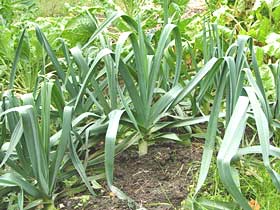






Leeks have an unfair reputation for being complicated to grow. These delicious, mild-tasting, non-bulbing onion relatives are in fact easy to start from seed and, with some simple techniques, produce long, white stalks that taste great in traditional leek and potato soup, braised in wine, or chopped in casseroles and risottos.
Leek cultivars fall into two broad categories. The less hardy short-season leeks are planted in the spring for harvest during the summer and early fall. The hardier long-season (100 or more days to maturity) leeks are also planted in the spring in the north and late summer or fall in the south. They can be harvested throughout the winter in mild climates and up until the ground freezes in northern areas. To develop the long, white stalks that are the part of the leek we use in cooking, plants need to be blanched, or have light excluded, by covering the stalks with soil as the plants grow.
Select a site with full sun and well-drained soil. Prepare the garden bed by using a garden fork or tiller to loosen the soil to a depth of 12 to 15 inches, then mix in a 2- to 4-inch layer of compost.
To start leeks from seed, sow indoors 8-10 weeks before the last expected spring frost. Plant seeds 1/2 inch deep in pots at least 6 inches deep, thinning to 1 inch apart when the seedlings are 3 inches tall. Growing conditions on the cool side (60-65°F) are best. Hardened-off seedlings can be set out in the garden as soon as the soil can be worked.
There are a couple of ways to set out the seedlings. One way is to dig a 6 inch deep trench and set the seedlings 6 inches apart in a row in the bottom of the trench. As they plants grow, gradually fill in the trench with soil, blanching the stalks in the process. You can also plant leek seedlings 8-10 inches apart in a wide row by poking holes with the handle of a rake or hoe about 6 inches deep, then dropping the seedlings into the holes. Water after you've set the seedlings in the holes and enough soil will wash in around them to cover the roots. The holes will fill in gradually on their own as the plants grow, covering the developing stalks. You can hill up additional soil around the plants to produce the longest white stalks.
To grow a crop to overwinter in southern areas, sow seeds 8-12 weeks before the first expected fall frost.
Leeks need a steady supply of nitrogen and plenty of water. Feed monthly with an organic fertilizer, such as fish emulsion. Keep the bed well weeded, as leeks will suffer from weed competition. Cover the leeks at planting time with a floating row cover sealed along its edges with soil to keep out the adult flies of the onion maggot, a pest that is found across the country. Silvery or rusty looking streaks on the leaves are signs of thrips damage; hose these pests off with a strong stream of water.
Begin harvesting leeks as soon as they are big enough to use; the slender young stalks are tasty braised. But for the biggest stalks, let short-season leeks grow until just before the first fall frosts. Be sure to loosen the soil around the leeks with a garden fork before pulling them up so they don't break off. Let the hardy long-season leeks remain in the garden until just before the ground freezes or throughout the winter in southern gardens. Mulching around the plants in fall with straw can extend your harvest season by keeping the soil from freezing. You can also harvest overwintered leeks in early spring before these biennial plants send up a flower stalk; after that, they'll be stringy and tough.
Harvested leeks will keep wrapped in plastic in the refrigerator for up to 2 weeks; cut off all but a few inches of the green tops to make them easier to store.
Copyright © www.100flowers.win Botanic Garden All Rights Reserved